Multi-Dimensional Benefit Evaluation of Urban Spaces Driven by Consumer Preferences
Abstract
1. Introduction
2. Literature Review and Theoretical Framework
2.1. Literature Review
2.2. Research Gap and Question
2.3. Theoretical Exposition and Conceptual Definition
2.3.1. Stimulus
2.3.2. Organism
2.3.3. Moderator
2.3.4. Response
3. Materials and Methods
3.1. Study Area
3.2. Data Sources and Processing
3.2.1. Consuming Behavior Data
3.2.2. Consumer Perception Data
3.2.3. Consumer Environment and Socio-Economic Data
3.3. Technical Routes
3.4. Methodology
3.4.1. Structural Equation Modeling
3.4.2. Hedonic Pricing Model
3.4.3. XGBoost Regression Model
3.4.4. Coupling Coordination Degree
3.4.5. Social Return on Investment
4. Results
4.1. Quantification of Spatial Element Value Based on Perception–Behavior Influence Mechanisms
4.1.1. Perception–Behavior Path Analysis
4.1.2. Quantification of Spatial Element Value
4.2. Spatial Coordination Coupling Analysis Driven by Consumption Preferences
4.2.1. Multidimensional Drivers of Consumption Preferences
4.2.2. Coordinated Coupling Degree and Spatial Matching
4.3. Multidimensional Spatial Benefit Assessment
4.3.1. Consumption-Driven Urban Spatial Value
4.3.2. Multidimensional Benefit Assessment of Urban Spaces
5. Discussion
5.1. The Underlying Logic of Spatial Benefit Distribution
5.2. Recommendations for Enhancing Urban Spatial Benefit Based on Consumer Preferences
5.3. Implications
5.4. Limitations and Prospects
6. Conclusions
Author Contributions
Funding
Institutional Review Board Statement
Informed Consent Statement
Data Availability Statement
Acknowledgments
Conflicts of Interest
Abbreviations
| SOR | Stimulus–Organism–Response |
| XGBoost | eXtreme Gradient Boosting |
| SROI | Social Return on Investment |
| CPI | City Prosperity Index |
| SEM | Structural Equation Modeling |
| HPM | Hedonic Pricing Model |
| CCD | Coordination Coupling Degree |
| TOD | Transit-Oriented Development |
Appendix A
Appendix A.1. Research Approach
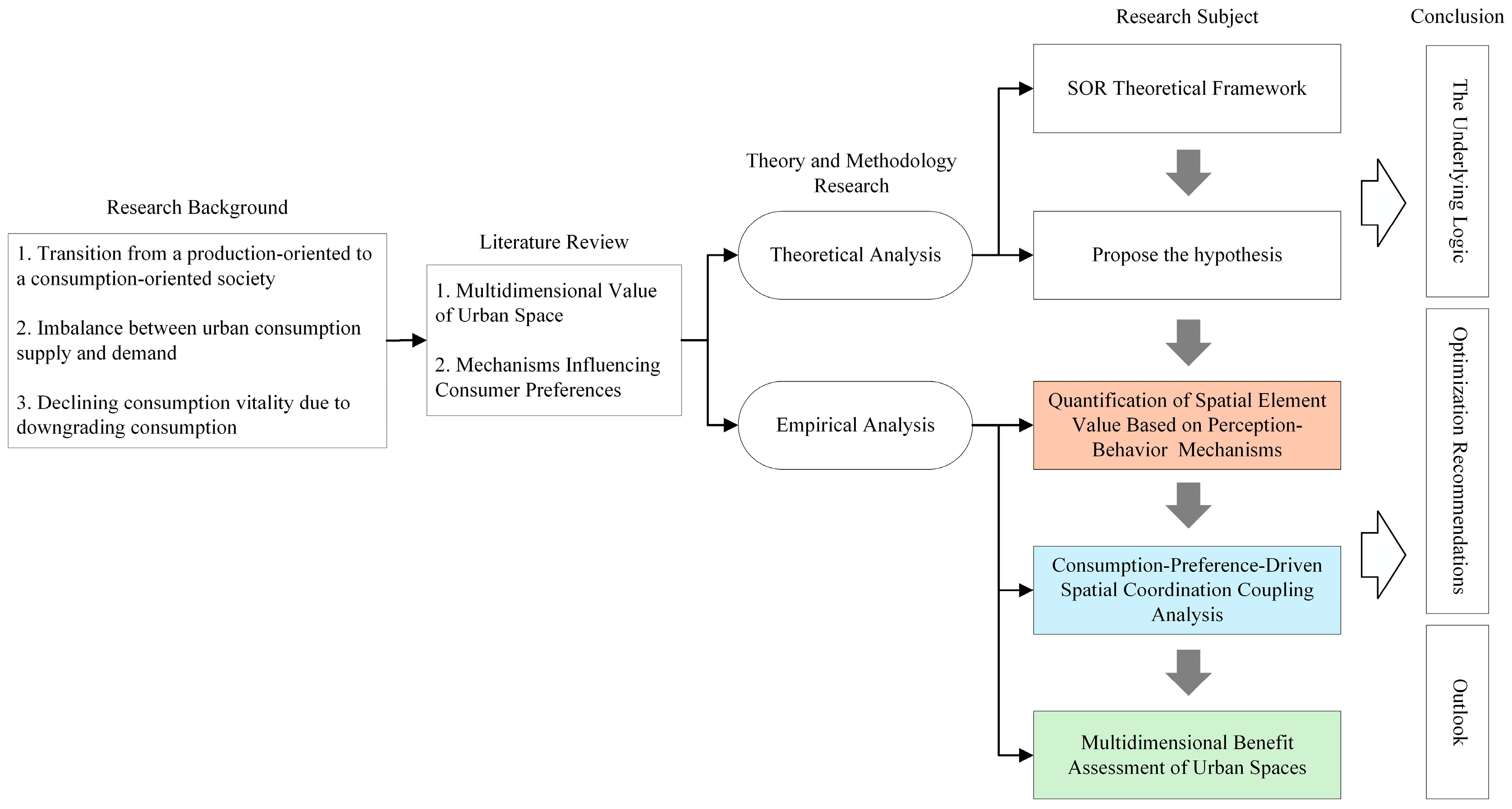
Appendix A.2. Spatial Distribution of Implicit Value in Consumption Environment Variables

Appendix A.3. The Investment Balance Point of Cost, Consumption Environment, and Supply-Demand Dynamics in Consumer Behavior

References
- Chen, W.; Cheshmehzangi, A.; Mangi, E.; Heath, T. Implementations of China’s New-Type Urbanisation: A Comparative Analysis between Targets and Practices of Key Elements’ Policies. Sustainability 2022, 14, 6341. [Google Scholar] [CrossRef]
- Zhang, M.; Tan, S.; Zhang, Y.; He, J.; Ni, Q. Does land transfer promote the development of new-type urbanization? New evidence from urban agglomerations in the middle reaches of the Yangtze River. Ecol. Indic. 2022, 136, 108705. [Google Scholar] [CrossRef]
- Tong, N.; Frazier, A.E.; Tong, L.; Hu, S. Synergistic pathways between urbanization and low-carbon development: Evidence from the Yangtze River Economic Belt. J. Environ. Manag. 2025, 392, 126740. [Google Scholar] [CrossRef] [PubMed]
- Lloyd, R.; Clark, T.N. The City as Entertainment Machine; Elsever JAI Press: New York, NY, USA, 2003; pp. 224–302. [Google Scholar]
- Hao, S.; Zhonggen, M. The Evolution Mechanismand Measurement Analysis of Consumption-oriented Cities. J. Stat. Inf. 2025, 40, 17–31. [Google Scholar] [CrossRef]
- Zhou, L. The Analysis of The Consumption Transformation and Degradation in China. J. Educ. Humanit. Soc. Sci. 2024, 38, 8–12. [Google Scholar] [CrossRef]
- Paudel, S.; States, S.L. Urban green spaces and sustainability: Exploring the ecosystem services and disservices of grassy lawns versus floral meadows. Urban For. Urban Green. 2023, 84, 127932. [Google Scholar] [CrossRef]
- Ruijgrok, E.C.M. The three economic values of cultural heritage: A case study in the Netherlands. J. Cult. Herit. 2006, 7, 206–213. [Google Scholar] [CrossRef]
- Rosen, S. Hedonic prices and implicit markets: Product differentiation in pure competition. J. Political Econ. 1974, 82, 34–55. [Google Scholar] [CrossRef]
- Herath, S. Elevating the Value of Urban Location: A Consumer Preference-Based Approach to Valuing Local Amenity Provision. Land 2021, 10, 1226. [Google Scholar] [CrossRef]
- Huang, W.; Lin, G. Concept, Benefits and Influencing Factors of Social Health Based on Urban Green Space. Chin. Landsc. Archit. 2023, 39, 77–82. [Google Scholar] [CrossRef]
- Wu, R.; Gao, L.; Li, J.; Xie, A.; Zhang, X. Exploring Key Factors Influencing the Processual Experience of Visitors in Metaverse Museum Exhibitions: An Approach Based on the Experience Economy and the SOR Model. Electronics 2025, 14, 3045. [Google Scholar] [CrossRef]
- Mouratidis, K. Urban planning and quality of life: A review of pathways linking the built environment to subjective well-being. Cities 2021, 115, 103229. [Google Scholar] [CrossRef]
- Gao, Y.; Du, D.; Furuya, N. Assessment framework of walking satisfaction on sidewalks in commercial districts: Combining built environment and personal attributes (applied in Japan). Front. Archit. Res. 2025, 14, 1380–1397. [Google Scholar] [CrossRef]
- Jennings, V.; Rigolon, A.; Thompson, J.; Murray, A.; Henderson, A.; Gragg, R.S. The Dynamic Relationship between Social Cohesion and Urban Green Space in Diverse Communities: Opportunities and Challenges to Public Health. Int. J. Environ. Res. Public Health 2024, 21, 800. [Google Scholar] [CrossRef] [PubMed]
- Wong, C. A framework for ‘City Prosperity Index’: Linking indicators, analysis and policy. Habitat Int. 2015, 45, 3–9. [Google Scholar] [CrossRef]
- Mitchell, A.; Larson, K.L.; Pfeiffer, D.; Rosales Chavez, J.-B. Planning for Urban Sustainability through Residents’ Wellbeing: The Effects of Nature Interactions, Social Capital, and Socio-Demographic Factors. Sustainability 2024, 16, 4160. [Google Scholar] [CrossRef]
- Zhu, J.; Lu, C.; Song, A. Air Pollution Governance and Residents’ Happiness: Evidence of Blue Sky Defense in China. Sustainability 2023, 15, 15288. [Google Scholar] [CrossRef]
- Naheed, S.; Shooshtarian, S. The Role of Cultural Heritage in Promoting Urban Sustainability: A Brief Review. Land 2022, 11, 1508. [Google Scholar] [CrossRef]
- Su, Y.; Xu, H.; Zhang, X. How Can Public Spaces Contribute to Increased Incomes for Urban Residents—A Social Capital Perspective. Land 2024, 13, 945. [Google Scholar] [CrossRef]
- Kolimenakis, A.; Solomou, A.D.; Proutsos, N.; Avramidou, E.V.; Korakaki, E.; Karetsos, G.; Maroulis, G.; Papagiannis, E.; Tsagkari, K. The Socioeconomic Welfare of Urban Green Areas and Parks; A Literature Review of Available Evidence. Sustainability 2021, 13, 7863. [Google Scholar] [CrossRef]
- Gao, S.; Li, C.; Rong, Y.; Yan, Q.; Liu, W.; Ma, Z. The Places—People Exercise: Understanding Spatial Patterns and the Formation Mechanism for Urban Commercial Fitness Space in Changchun City, China. Sustainability 2022, 14, 1358. [Google Scholar] [CrossRef]
- Liu, R.; Xiao, J. Factors Affecting Users’ Satisfaction with Urban Parks through Online Comments Data: Evidence from Shenzhen, China. Int. J. Environ. Res. Public Health 2021, 18, 253. [Google Scholar] [CrossRef]
- Song, H.; Chen, J.; Li, P. Decoding the cultural heritage tourism landscape and visitor crowding behavior from the multidimensional embodied perspective: Insights from Chinese classical gardens. Tour. Manag. 2025, 110, 105180. [Google Scholar] [CrossRef]
- Zhou, Q.; Wang, Y. Research on the Variable Factors Influencing the Vitality of Commercial Districts Based on the SOR Theory Model. Buildings 2025, 15, 1868. [Google Scholar] [CrossRef]
- Li, Y.; Yao, M.; Shen, L. The Influencing Factors and Paths of the Social Benefits of Rural Micro-landscapes: Mediated by Perceived Quality and Activity Level. Chin. Landsc. Archit. 2024, 40, 87–92. [Google Scholar] [CrossRef]
- Tong, L.L.; Wei, X.Y.; Song, X.H.; Mao, X.F.; Jin, X.; Jin, Y.X.; Ji, H.; Ji, H.S.; Tang, W.J. A Hedonic-Price and Structural-Equation Model based value assessment and factors of ecosystem services of urban wetlands in the Xining City. Acta Ecol. Sin. 2022, 42, 4630–4639. [Google Scholar] [CrossRef]
- Łaszkiewicz, E.; Heyman, A.; Chen, X.; Cimburova, Z.; Nowell, M.; Barton, D.N. Valuing access to urban greenspace using non-linear distance decay in hedonic property pricing. Ecosyst. Serv. 2022, 53, 101394. [Google Scholar] [CrossRef]
- Lee, J.-W.; Lee, S.-W.; Kim, H.G.; Jo, H.-K.; Park, S.-R. Green Space and Apartment Prices: Exploring the Effects of the Green Space Ratio and Visual Greenery. Land 2023, 12, 2069. [Google Scholar] [CrossRef]
- Jiang, X.; Ji, L.; Chen, Y.; Zhou, C.; Ge, C.; Zhang, X. How to Improve the Well-Being of Youths: An Exploratory Study of the Relationships Among Coping Style, Emotion Regulation, and Subjective Well-Being Using the Random Forest Classification and Structural Equation Modeling. Front. Psychol. 2021, 12, 637712. [Google Scholar] [CrossRef]
- Spasojevic, M.; Grace, J.; Harrison, S.; Damschen, E. Functional diversity supports the physiological tolerance hypothesis for plant species richness along climatic gradients. J. Ecol. 2013, 102, 447–455. [Google Scholar] [CrossRef]
- Han, X.; Li, Z.; Chen, H.; Yu, M.; Shi, Y. Structural Equation Model in Landscape Performance Research: Dimensions, Methodologies, and Recommendations. Land 2025, 14, 646. [Google Scholar] [CrossRef]
- Ruiz de Gopegui, M.; Olazabal, M.; Castán Broto, V.; McPhearson, T. Climate justice in urban public space adaptation: Developing and testing a collective assessment tool in Hunters Point, New York City. Urban Clim. 2025, 62, 102505. [Google Scholar] [CrossRef]
- Xu, F.; Yan, Q.; Ding, Z. A study on perception of urban green space carbon sequestration based on biotope classification: A case study of the Urban Forest in Shanghai. Trees For. People 2025, 22, 101047. [Google Scholar] [CrossRef]
- Xu, Q.; Ma, X.; Ding, Z.; Wang, H. Unlocking urban green spaces: Retrofitting potential green roofs to enhance bird connectivity and comprehensive ecological benefits in high-density areas. Urban For. Urban Green. 2025, 107, 128817. [Google Scholar] [CrossRef]
- Alita, L.; Zhang, J. Does user-generated content increase the valuation of urban green space? Evidence from China. Urban For. Urban Green. 2025, 113, 129086. [Google Scholar] [CrossRef]
- Wang, Y.; Shen, J.; Xiang, W. The Framework of Landscape Space Performance Evaluation with the Orientation of Eco-system Service. Landsc. Archit. 2017, 24, 35–44. [Google Scholar] [CrossRef]
- Chen, Y.; Liu, G.; Zhuang, T. Evaluating the Comprehensive Benefit of Urban Renewal Projects on the Area Scale: An Integrated Method. Int. J. Environ. Res. Public Health 2022, 20, 606. [Google Scholar] [CrossRef] [PubMed]
- Xue, J.; Shuhan, M.; Nan, L. Review on Social Benefits of Urban Green Space. Archit. Cult. 2024, 2024, 254–256. [Google Scholar] [CrossRef]
- Peng, X.; Niu, Y.-y.; Meng, B.; Tao, Y.; Huang, Z. Big geo-data unveils influencing factors on customer flow dynamics within urban commercial districts. Int. J. Appl. Earth Obs. Geoinf. 2024, 134, 104231. [Google Scholar] [CrossRef]
- Lei, T.; Hu, H.; Feng, G.; Wang, L.; Chen, Y.; Chen, B.; Wang, J. Evaluation and application of public space in commercial buildings based on user behaviour needs. Alex. Eng. J. 2025, 125, 29–41. [Google Scholar] [CrossRef]
- Tinessa, F.; Pagliara, F.; Biggiero, L.; Delli Veneri, G. Walkability, accessibility to metro stations and retail location choice: Some evidence from the case study of Naples. Res. Transp. Bus. Manag. 2021, 40, 100549. [Google Scholar] [CrossRef]
- Higgins, C.D.; Arku, R.N.; Farber, S.; Miller, E.J. Modelling changes in accessibility and property values associated with the King Street Transit Priority Corridor project in Toronto. Transp. Res. Part A Policy Pract. 2024, 190, 104256. [Google Scholar] [CrossRef]
- Chan, S.H.G.; Lee, W.H.H.; Tang, B.M.; Chen, Z. Legacy of culture heritage building revitalization: Place attachment and culture identity. Front. Psychol. 2023, 14, 1314223. [Google Scholar] [CrossRef] [PubMed]
- Mäntymaa, E.; Jokinen, M.; Juutinen, A.; Lankia, T.; Louhi, P. Providing ecological, cultural and commercial services in an urban park: A travel cost-contingent behavior application in Finland. Landsc. Urban Plan. 2021, 209, 104042. [Google Scholar] [CrossRef]
- Shi, X.; Liu, D.; Gan, J. A Study on the Relationship between Road Network Centrality and the Spatial Distribution of Commercial Facilities—A Case of Changchun, China. Sustainability 2024, 16, 3920. [Google Scholar] [CrossRef]
- Li, Y. Common Sharing or Public Sharing: A Study on the Choice Behavior of Urban Citizens in Public Travel. Sustainability 2022, 14, 9459. [Google Scholar] [CrossRef]
- Meng, Q.Y.; Zhang, L.L.; Wang, X.M.; Hu, X.L.; Allam, M.; Wu, J.H.; Yan, M.; Qi, J.N.; Zhai, W.F. Travel preference: An indicator of the benefits of urban green space. Int. J. Digit. Earth 2024, 17, 2342978. [Google Scholar] [CrossRef]
- Hochreiter, V.; Benedetto, C.; Loesch, M. The Stimulus-Organism-Response (S-O-R) Paradigm as a Guiding Principle in Environmental Psychology: Comparison of its Usage in Consumer Behavior and Organizational Culture and Leadership Theory. J. Entrep. Bus. Dev. 2023, 3, 7–16. [Google Scholar] [CrossRef]
- Nigg, C.; Fiedler, J.; Burchartz, A.; Reichert, M.; Niessner, C.; Woll, A.; Schipperijn, J. Associations between green space availability and youth’s physical activity in urban and rural areas across Germany. Landsc. Urban Plan. 2024, 247, 105068. [Google Scholar] [CrossRef]
- Wang, P.; Zhou, B.; Ya, J.; Han, L.; Zhu, Y. The impact of perceived restorative destination environments on tourists’ willingness-To-Pay for environmental protection. Sci. Rep. 2025, 15, 19989. [Google Scholar] [CrossRef]
- Chen, C.-T. Atmospherics fosters customer loyalty: Exploring the mediating effects of memorable customer experience and customer satisfaction in factory outlet malls in Taiwan. J. Retail. Consum. Serv. 2024, 80, 103936. [Google Scholar] [CrossRef]
- Guo, X.; Yao, J.; Fu, P. Willingness effect of ecological consumption behavior choices on the perception of cultural service value in tourist ecosystem. J. Cent. China Norm. Univ. Nat. Sci. Ed. 2022, 56, 882–890. [Google Scholar] [CrossRef]
- Wei, Y.; Kim, Y. Intangible Cultural Heritage (ICH) Cultural Identity Perception and ICH Authenticity Perception impact on consumption intention of ICH products in China. Rev. Cult. Econ. 2024, 27, 73–106. [Google Scholar] [CrossRef]
- Fu, Y.; Dong, W. How perceived value, environmental awareness, and social identity shape public support for industrial heritage: The mediating role of place attachment. Front. Psychol. 2025, 16, 1645646. [Google Scholar] [CrossRef]
- Helinski, C.; Schewe, G. The Influence of Consumer Preferences and Perceived Benefits in the Context of B2C Fashion Renting Intentions of Young Women. Sustainability 2022, 14, 9407. [Google Scholar] [CrossRef]
- Ji, Y.; Wang, Z.; Zhu, D. Exploring the Impact of Urban Amenities on Business Circle Vitality Using Multi-Source Big Data. Land 2024, 13, 1616. [Google Scholar] [CrossRef]
- Wu, W.; Chen, W.Y.; Yun, Y.; Wang, F.; Gong, Z. Urban greenness, mixed land-use, and life satisfaction: Evidence from residential locations and workplace settings in Beijing. Landsc. Urban Plan. 2022, 224, 104428. [Google Scholar] [CrossRef]
- Liu, S.; Liu, W.; Zhou, Y.; Wang, S.; Wang, Z.; Wang, Z.; Wang, Y.; Wang, X.; Hao, L.; Wang, F. Analysis of Economic Vitality and Development Equilibrium of China’s Three Major Urban Agglomerations Based on Nighttime Light Data. Remote Sens. 2024, 16, 4571. [Google Scholar] [CrossRef]
- Peng, D.; Elahi, E.; Khalid, Z. Productive Service Agglomeration, Human Capital Level, and Urban Economic Performance. Sustainability 2023, 15, 7051. [Google Scholar] [CrossRef]
- Zhou, Q.; Lei, Y.; Tian, L.; Ai, S.; Yang, Y.; Zhu, Y. Perception and sentiment analysis of palliative care in Chinese social media: Qualitative studies based on machine learning. Soc. Sci. Med. 2025, 379, 118178. [Google Scholar] [CrossRef]
- Chen, T.Q.; Guestrin, C.; Assoc Comp, M. XGBoost: A Scalable Tree Boosting System. In Proceedings of the 22nd ACM SIGKDD International Conference on Knowledge Discovery and Data Mining (KDD), San Francisco, CA, USA, 13–17 August 2016; pp. 785–794. [Google Scholar]
- Helili, P.; Zan, M. Coupling Coordination Development of Urbanization and Ecological Environment in the Urban Agglomeration on the Northern Slope of the Tianshan Mountains, China. Sustainability 2023, 15, 4099. [Google Scholar] [CrossRef]
- Vasiliu, E.-E.; Torabi Moghadam, S.; Bisello, A.; Lombardi, P. Visionary Nature-Based Solutions Evaluated through Social Return on Investment: The Case Study of an Italian Urban Green Space. Smart Cities 2024, 7, 946–972. [Google Scholar] [CrossRef]
- Lv, D.; Qin, S.; Sun, R.; Jiang, X.; Cheng, R.; Sun, W. The Impact of Natural and Cultural Landscape Quality on Attachment to Place and the Intention to Recommend Tourism in a UNESCO World Heritage City. Land 2025, 14, 1405. [Google Scholar] [CrossRef]
- Vilnai-Yavetz, I.; Gilboa, S.; Mitchell, V. Experiencing atmospherics: The moderating effect of mall experiences on the impact of individual store atmospherics on spending behavior and mall loyalty. J. Retail. Consum. Serv. 2021, 63, 102704. [Google Scholar] [CrossRef]
- Zhang, E.; Zhou, Y.; Chen, G.; Wang, G. Classified Spatial Clustering and Influencing Factors of New Retail Stores: A Case Study of Freshippo in Shanghai. Sustainability 2024, 16, 6643. [Google Scholar] [CrossRef]
- Zhou, R.; Wang, C.; Bao, D.; Xu, X. Shopping Mall Site Selection Based on Consumer Behavior Changes in the New Retail Era. Land 2024, 13, 855. [Google Scholar] [CrossRef]
- Fang, H.; Li, R.; Li, W. Urban Shrinkage and Labor Investment Efficiency: Evidence from China. Sustainability 2023, 15, 10738. [Google Scholar] [CrossRef]
- Gao, J.; Lin, S.; Zhang, C. Authenticity, involvement, and nostalgia: Understanding visitor satisfaction with an adaptive reuse heritage site in urban China. J. Destin. Mark. Manag. 2020, 15, 100404. [Google Scholar] [CrossRef]
- Shi, H.; Zhao, M.; Simth, D.A.; Chi, B. Behind the Land Use Mix: Measuring the Functional Compatibility in Urban and Sub-Urban Areas of China. Land 2022, 11, 2. [Google Scholar] [CrossRef]
- Stadler, M. Location in a Disk City with Consumer Concentration Around the Center. Schmalenbach Bus. Rev. 2019, 71, 35–50. [Google Scholar] [CrossRef]
- Blazy, R.; Łabuz, R. Spatial Distribution and Land Development Parameters of Shopping Centers Based on GIS Analysis: A Case Study on Kraków, Poland. Sustainability 2022, 14, 7539. [Google Scholar] [CrossRef]
- Lima, L.; Maraschin, C.; Giaccom, B.; Giusti, C. Urban spatial configuration and interactions with retail activities: An approach based on contact. Cities 2024, 146, 104783. [Google Scholar] [CrossRef]
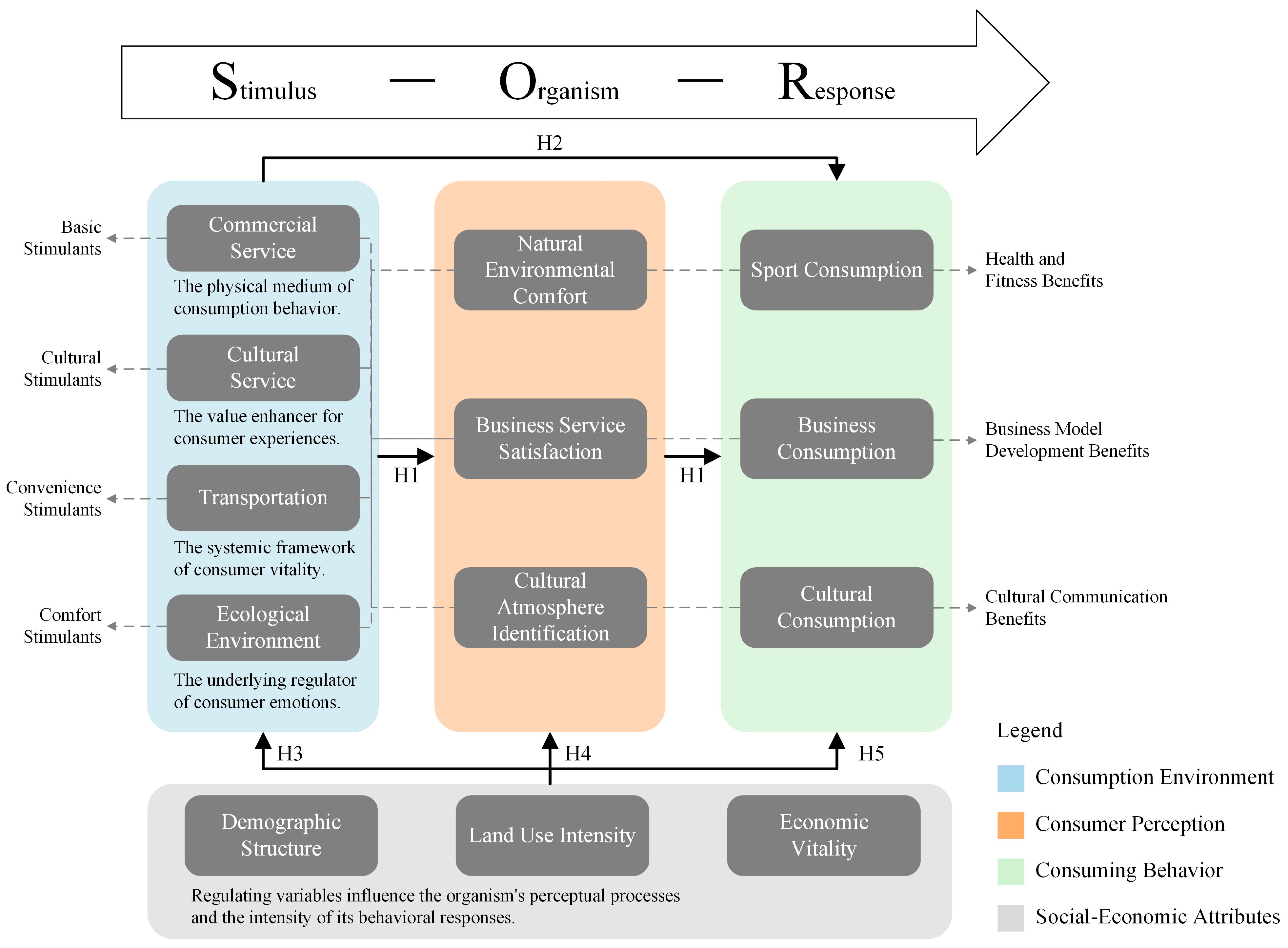
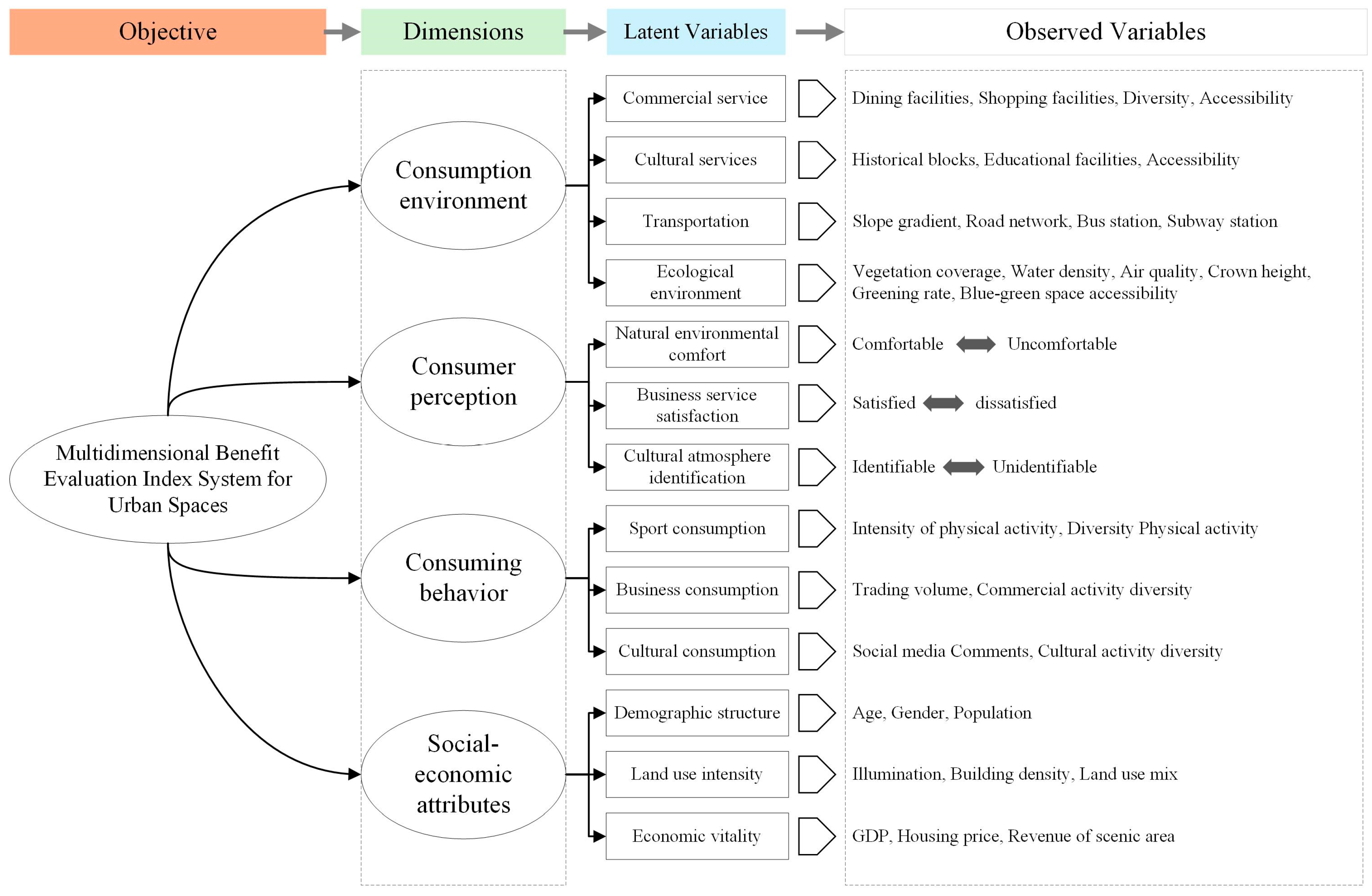

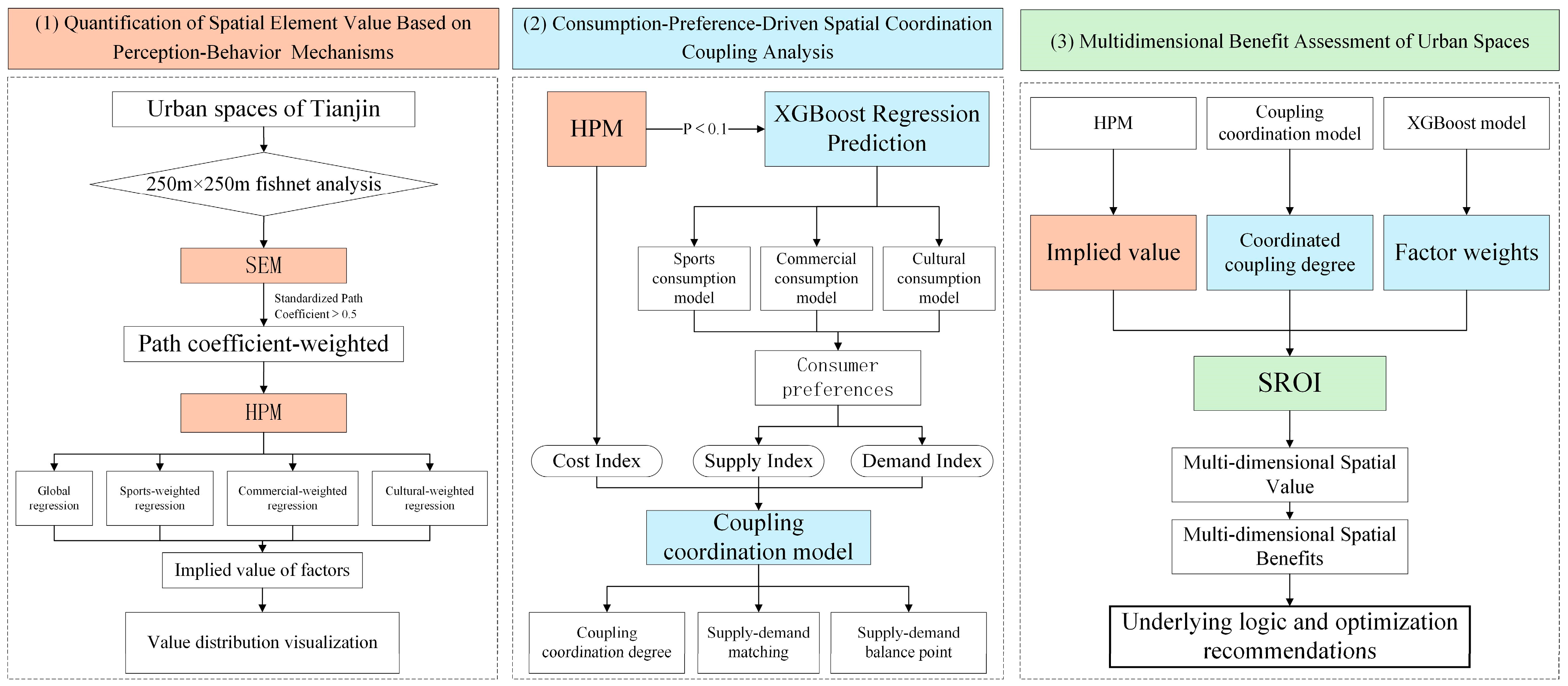

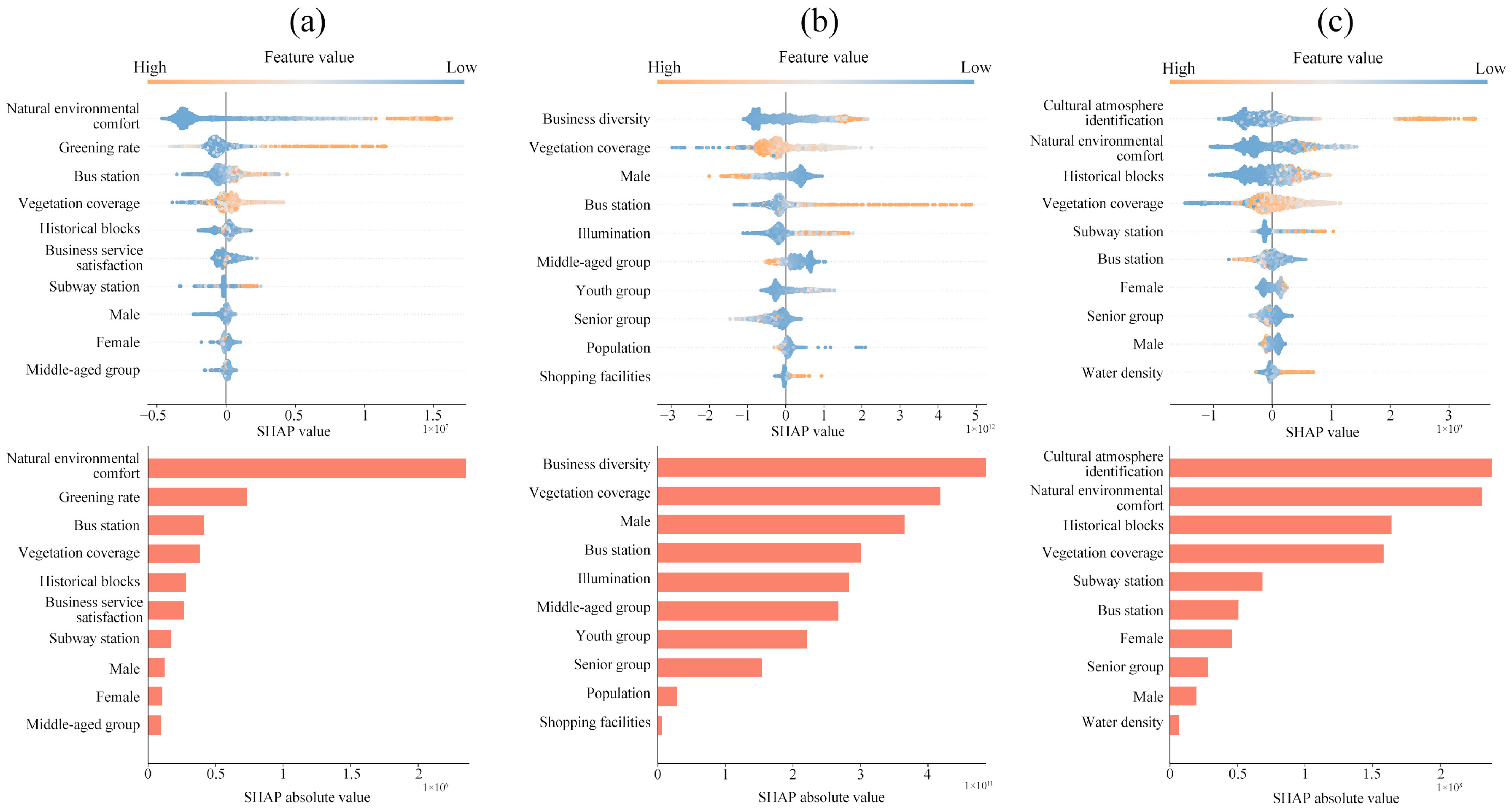
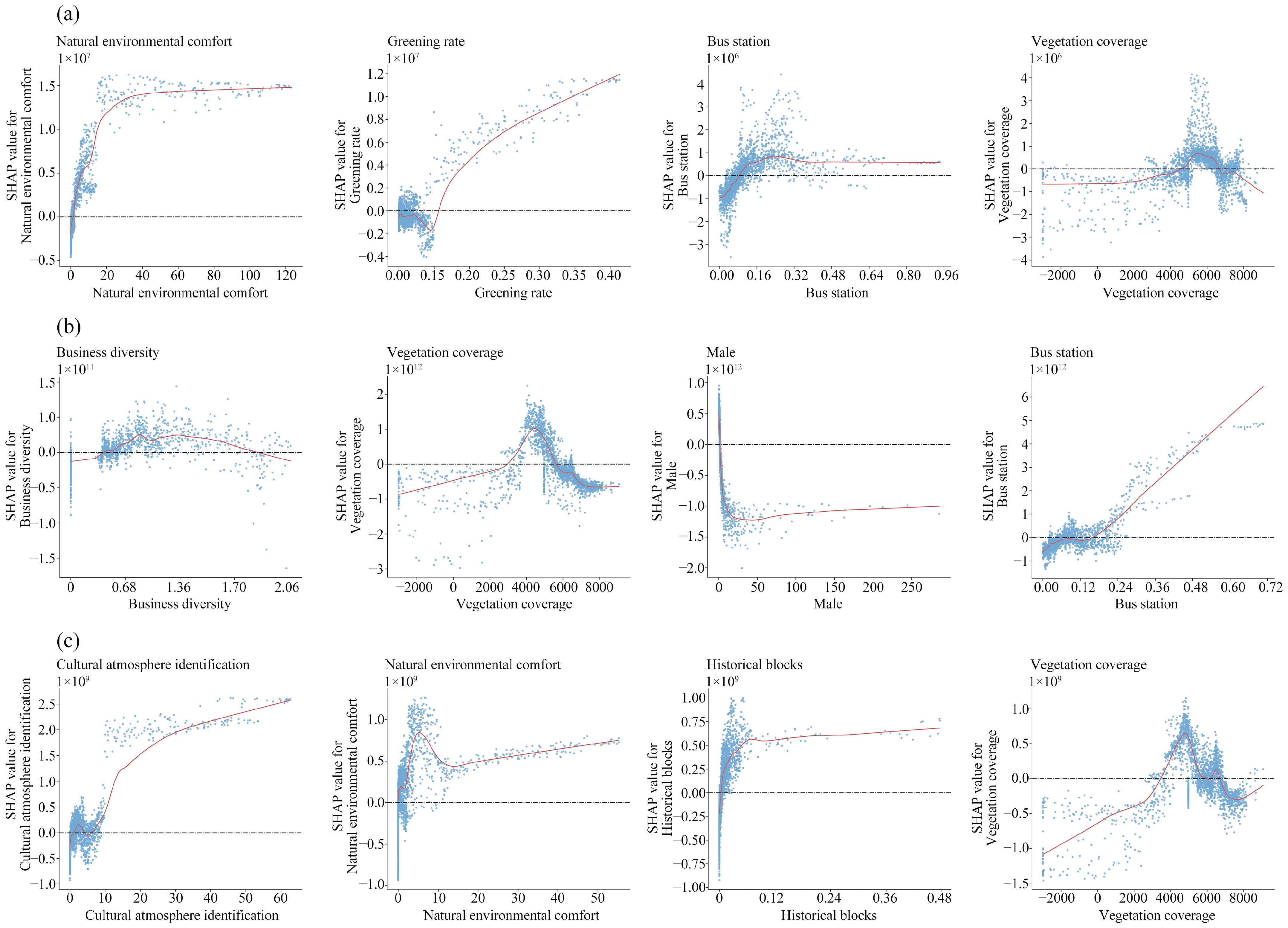
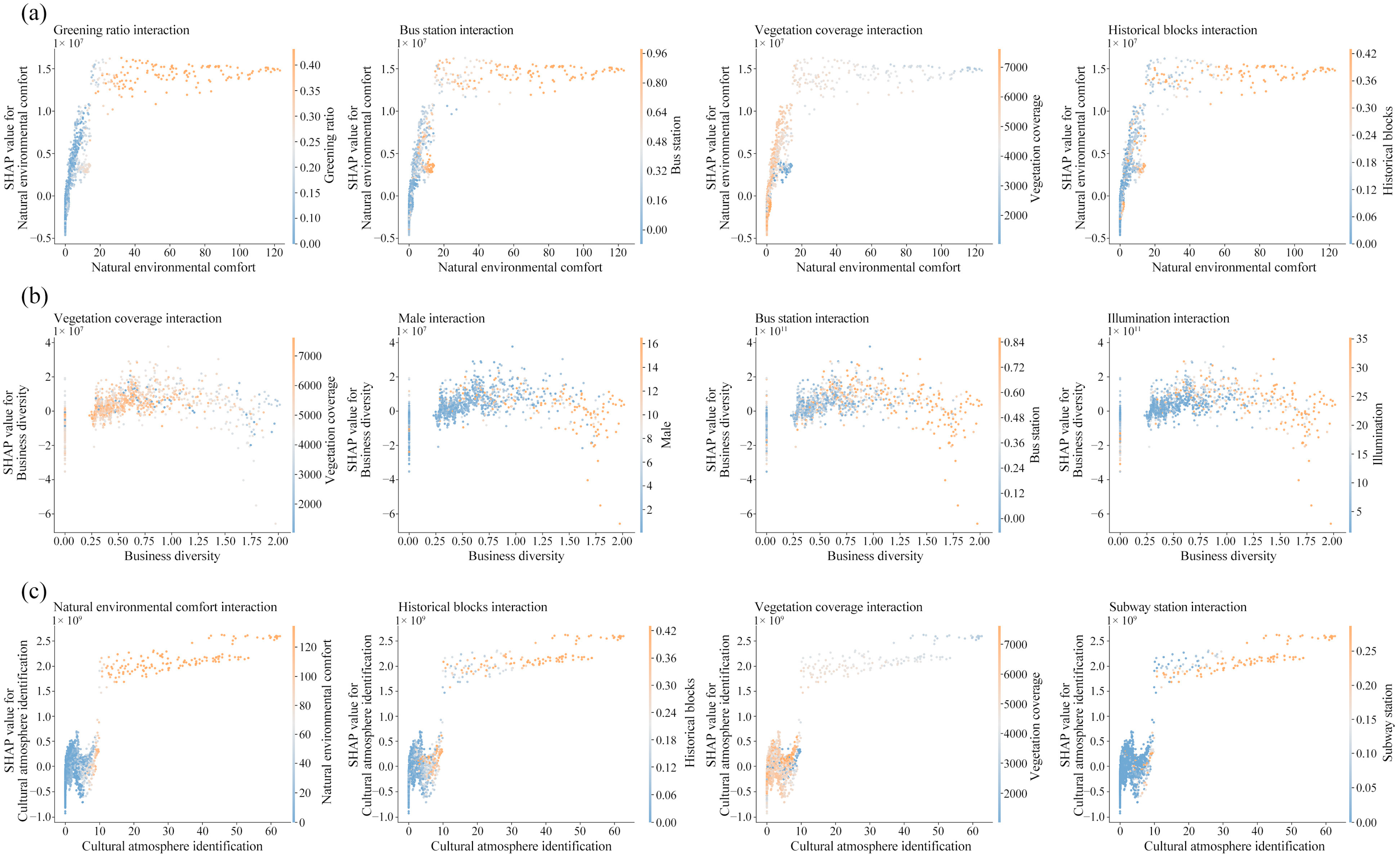
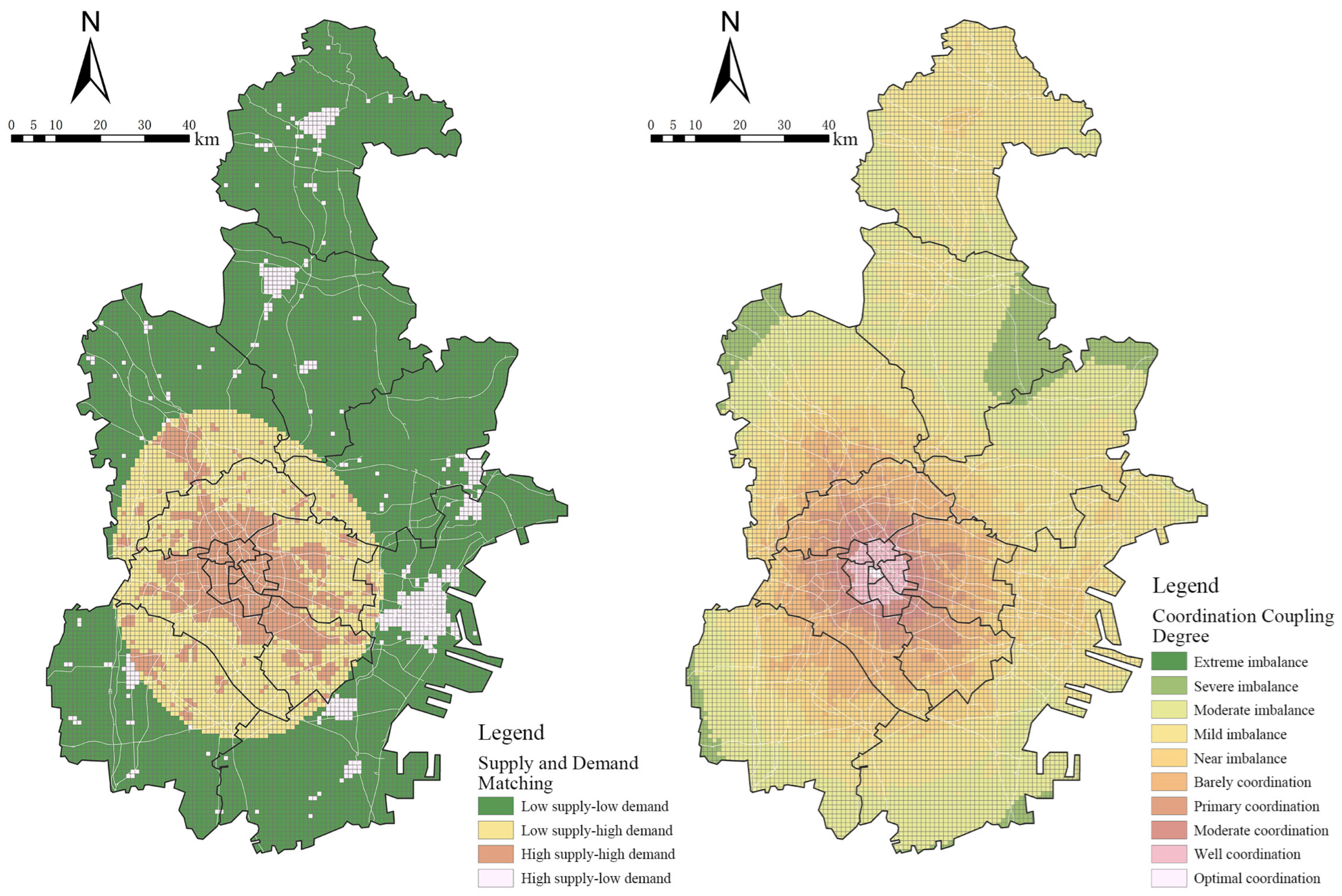
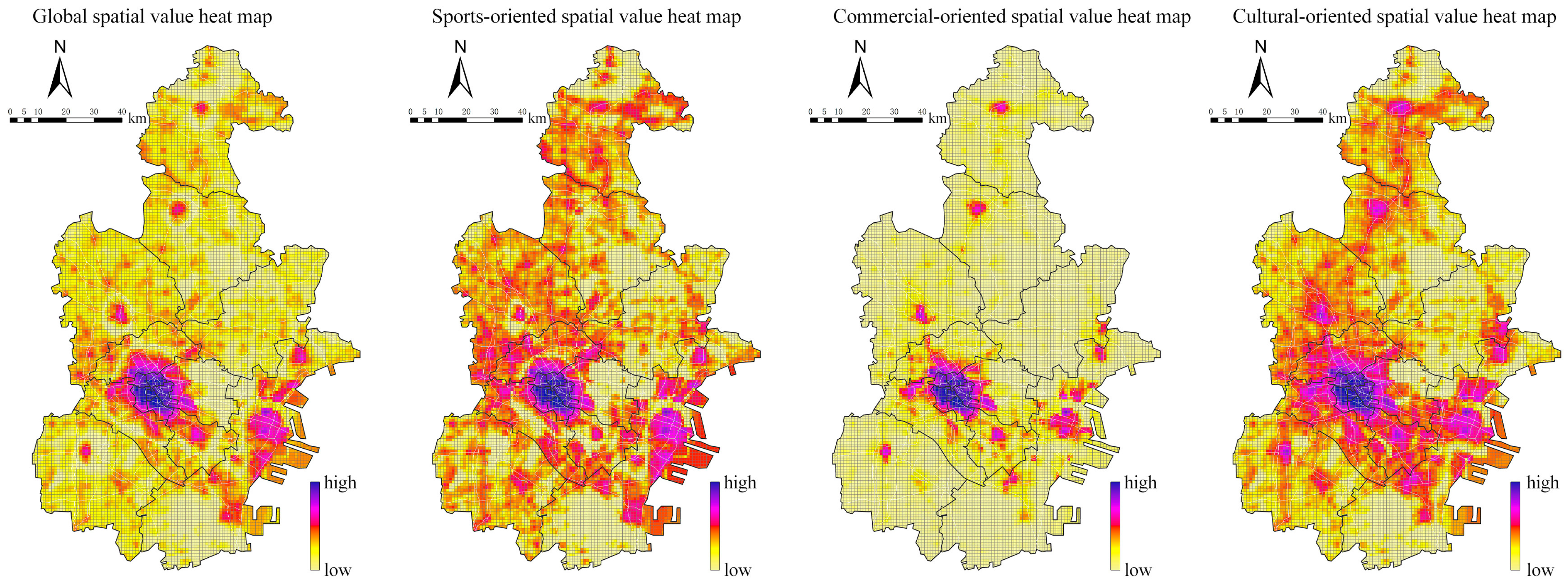
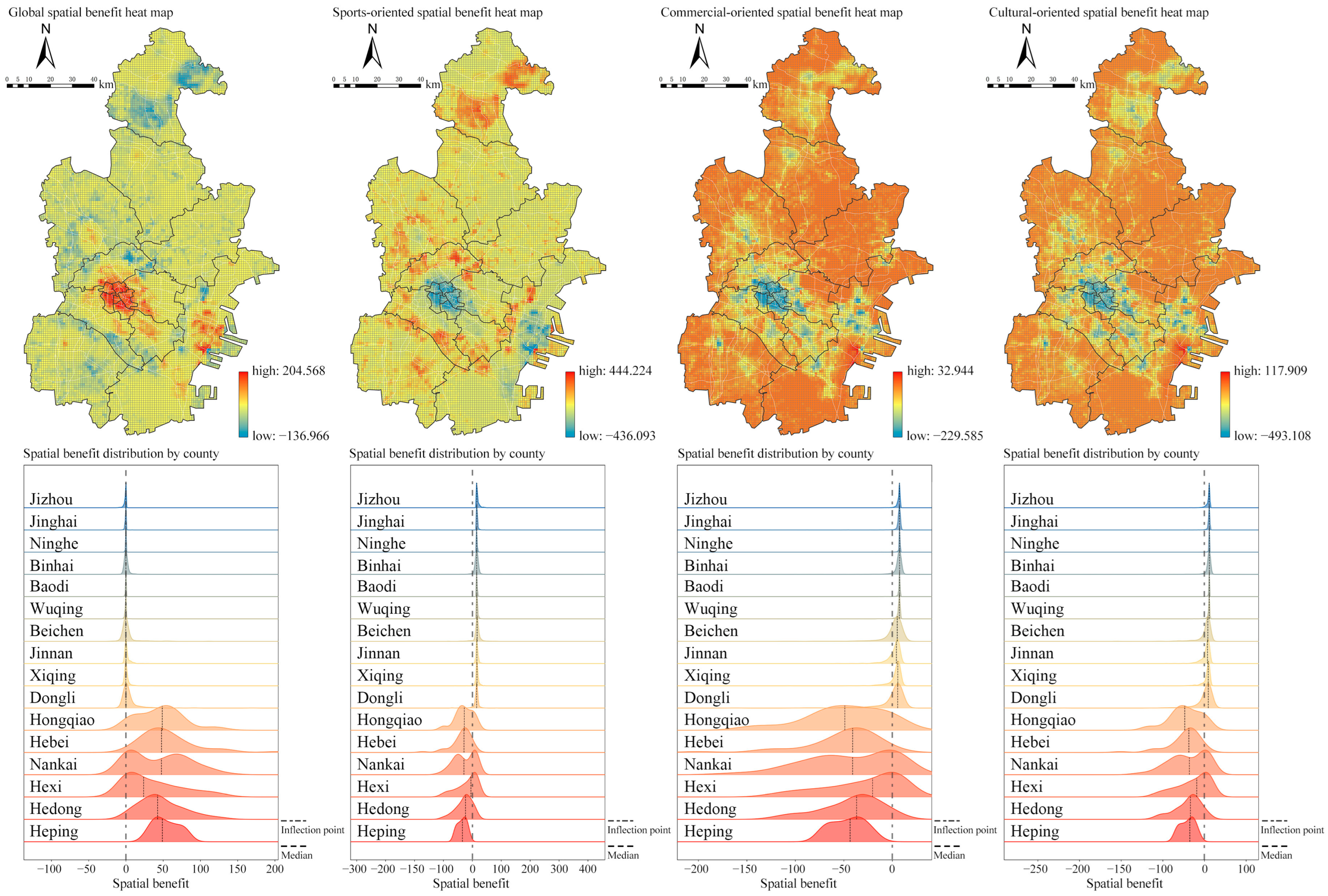
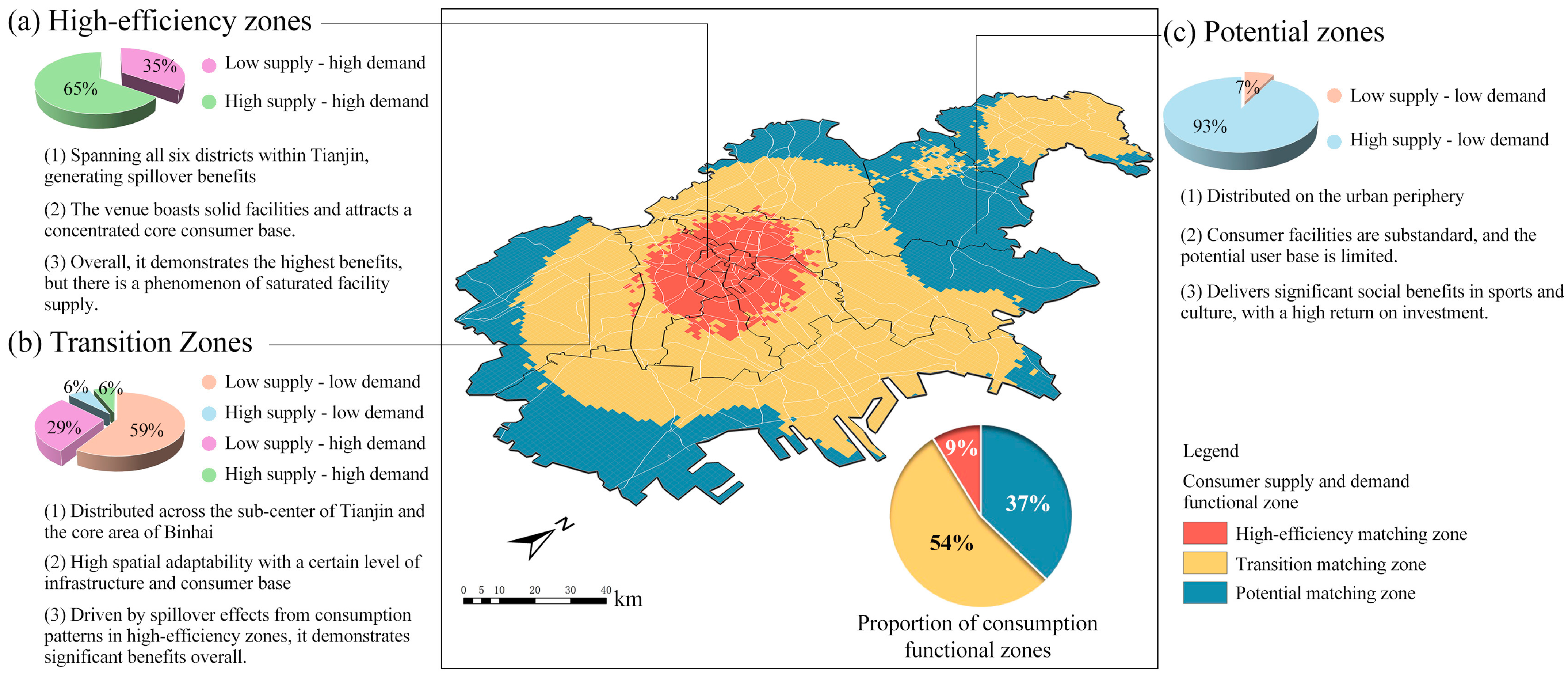
| Global Regression | Sports Consumption Weighted | Business Consumption Weighted | Cultural Consumption Weighted | |||||
|---|---|---|---|---|---|---|---|---|
| B | p > |t| | B | p > |t| | B | p > |t| | B | p > |t| | |
| Constant | 0.119 | 1.000 | 0.014 | 0.281 | −0.120 *** | 0.000 | 0.048 *** | 0.000 |
| Dining facilities | 0.014 | 0.524 | 0.007 | 0.632 | 0.001 | 0.993 | 0.003 | 0.818 |
| Shopping facilities | 0.017 | 0.448 | 0.003 | 0.818 | 0.134 ** | 0.029 | 0.002 | 0.844 |
| Business diversity | 0.065 *** | 0.009 | −0.076 ** | 0.015 | 0.250 ** | 0.032 | −0.045 * | 0.080 |
| Historical blocks | 0.120 *** | 0.000 | 0.050 *** | 0.006 | 0.007 | 0.616 | 0.057 *** | 0.001 |
| Road network | 0.080 *** | 0.000 | 0.044 *** | 0.002 | 0.020 * | 0.094 | 0.036 *** | 0.004 |
| Bus station | 0.063 *** | 0.001 | −0.116 *** | 0.000 | −0.111 *** | 0.000 | −0.089 *** | 0.000 |
| Subway station | 0.120 *** | 0.000 | −0.058 *** | 0.007 | 0.001 | 0.934 | −0.066 *** | 0.001 |
| Vegetation coverage | −0.163 *** | 0.000 | 0.443 *** | 0.000 | −0.133 *** | 0.000 | −0.181 *** | 0.000 |
| Water density | −0.021 ** | 0.019 | −0.020 | 0.186 | 0.002 | 0.989 | 0.024 ** | 0.014 |
| Greening rate | −0.019 ** | 0.024 | 0.049 *** | 0.000 | −0.023 | 0.122 | −0.022 *** | 0.001 |
| Blue−green space accessibility | 0.007 | 0.482 | −0.002 | 0.988 | 0.024 * | 0.054 | 0.010 | 0.362 |
| Business service satisfaction | 0.825 *** | 0.000 | −0.383 *** | 0.000 | 0.009 | 0.827 | −0.366 | 0.109 |
| Cultural atmosphere identification | 0.361 *** | 0.000 | 0.021 *** | 0.000 | 0.039 | 0.435 | 0.139 *** | 0.003 |
| Natural environmental comfort | −1.268 *** | 0.000 | 0.683 *** | 0.000 | −0.166 | 0.066 | 0.622 *** | 0.000 |
| Population | −0.152 | 0.199 | −0.018 | 0.924 | 0.312 * | 0.088 | 0.128 | 0.384 |
| Age | 0.291 | 0.137 | 0.031 ** | 0.017 | 0.970 *** | 0.010 | 0.018 * | 0.093 |
| Gender | 0.147 | 0.137 | 0.002 ** | 0.011 | 0.280 * | 0.090 | 0.143 * | 0.088 |
| Land use mix | 0.059 ** | 0.019 | 0.074 ** | 0.035 | 0.036 | 0.268 | 0.035 | 0.212 |
| Illumination | 0.123 ** | 0.000 | 0.092 *** | 0.000 | −0.039 ** | 0.032 | −0.061 *** | 0.000 |
| Adjusted R2 | 0.75 | Adjusted R2 | 0.77 | Adjusted R2 | 0.68 | Adjusted R2 | 0.73 | |
| Model | R2 | RMSE | MAE |
|---|---|---|---|
| Sports consumption | 0.87 | 0.75 | 2.18 |
| Business consumption | 0.85 | 2.87 | 5.77 |
| Cultural consumption | 0.94 | 0.18 | 0.62 |
Disclaimer/Publisher’s Note: The statements, opinions and data contained in all publications are solely those of the individual author(s) and contributor(s) and not of MDPI and/or the editor(s). MDPI and/or the editor(s) disclaim responsibility for any injury to people or property resulting from any ideas, methods, instructions or products referred to in the content. |
© 2025 by the authors. Licensee MDPI, Basel, Switzerland. This article is an open access article distributed under the terms and conditions of the Creative Commons Attribution (CC BY) license (https://creativecommons.org/licenses/by/4.0/).
Share and Cite
Zhang, X.; Yu, Y.; Cao, L. Multi-Dimensional Benefit Evaluation of Urban Spaces Driven by Consumer Preferences. Land 2025, 14, 2322. https://doi.org/10.3390/land14122322
Zhang X, Yu Y, Cao L. Multi-Dimensional Benefit Evaluation of Urban Spaces Driven by Consumer Preferences. Land. 2025; 14(12):2322. https://doi.org/10.3390/land14122322
Chicago/Turabian StyleZhang, Xin, Yi Yu, and Lei Cao. 2025. "Multi-Dimensional Benefit Evaluation of Urban Spaces Driven by Consumer Preferences" Land 14, no. 12: 2322. https://doi.org/10.3390/land14122322
APA StyleZhang, X., Yu, Y., & Cao, L. (2025). Multi-Dimensional Benefit Evaluation of Urban Spaces Driven by Consumer Preferences. Land, 14(12), 2322. https://doi.org/10.3390/land14122322




